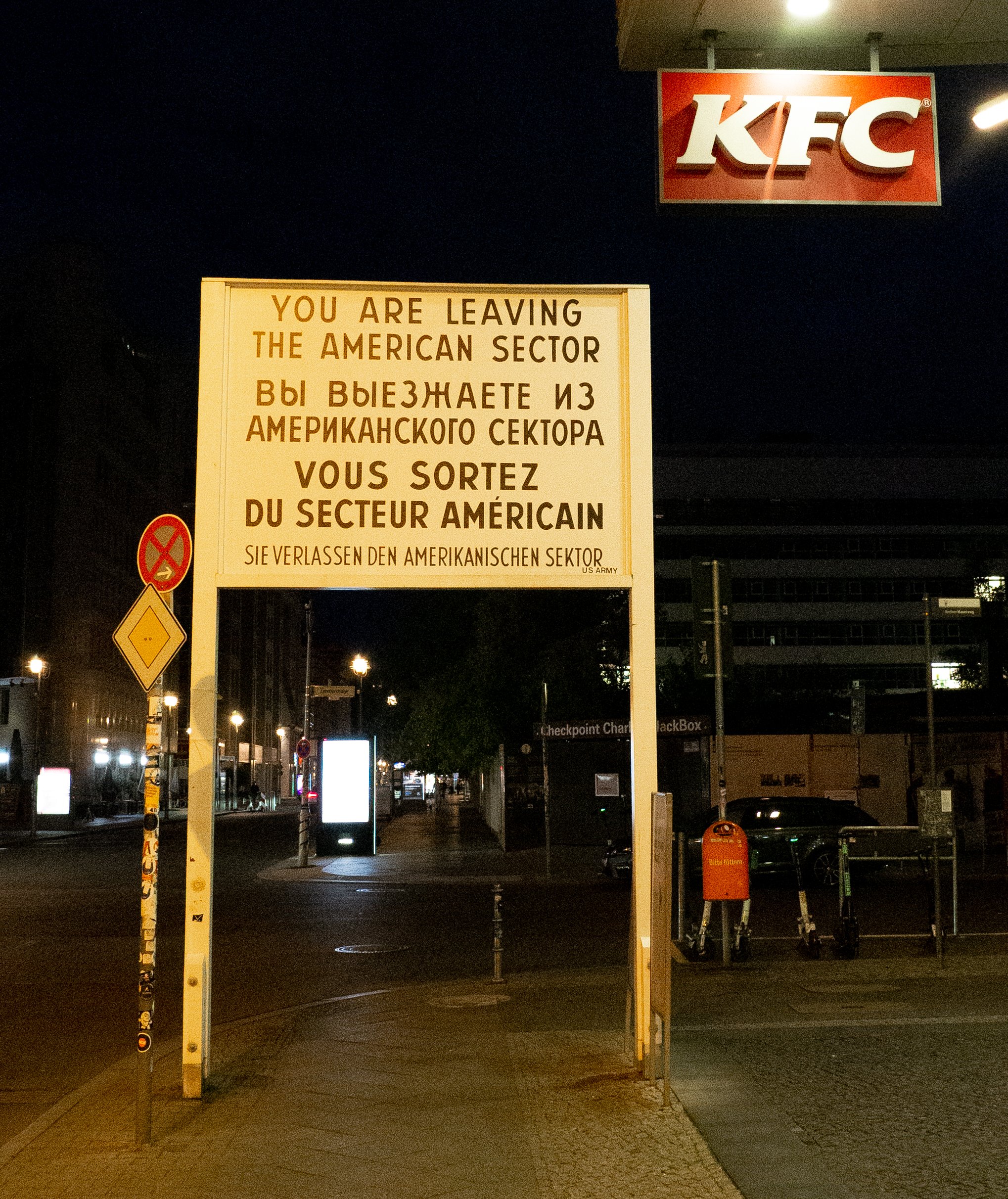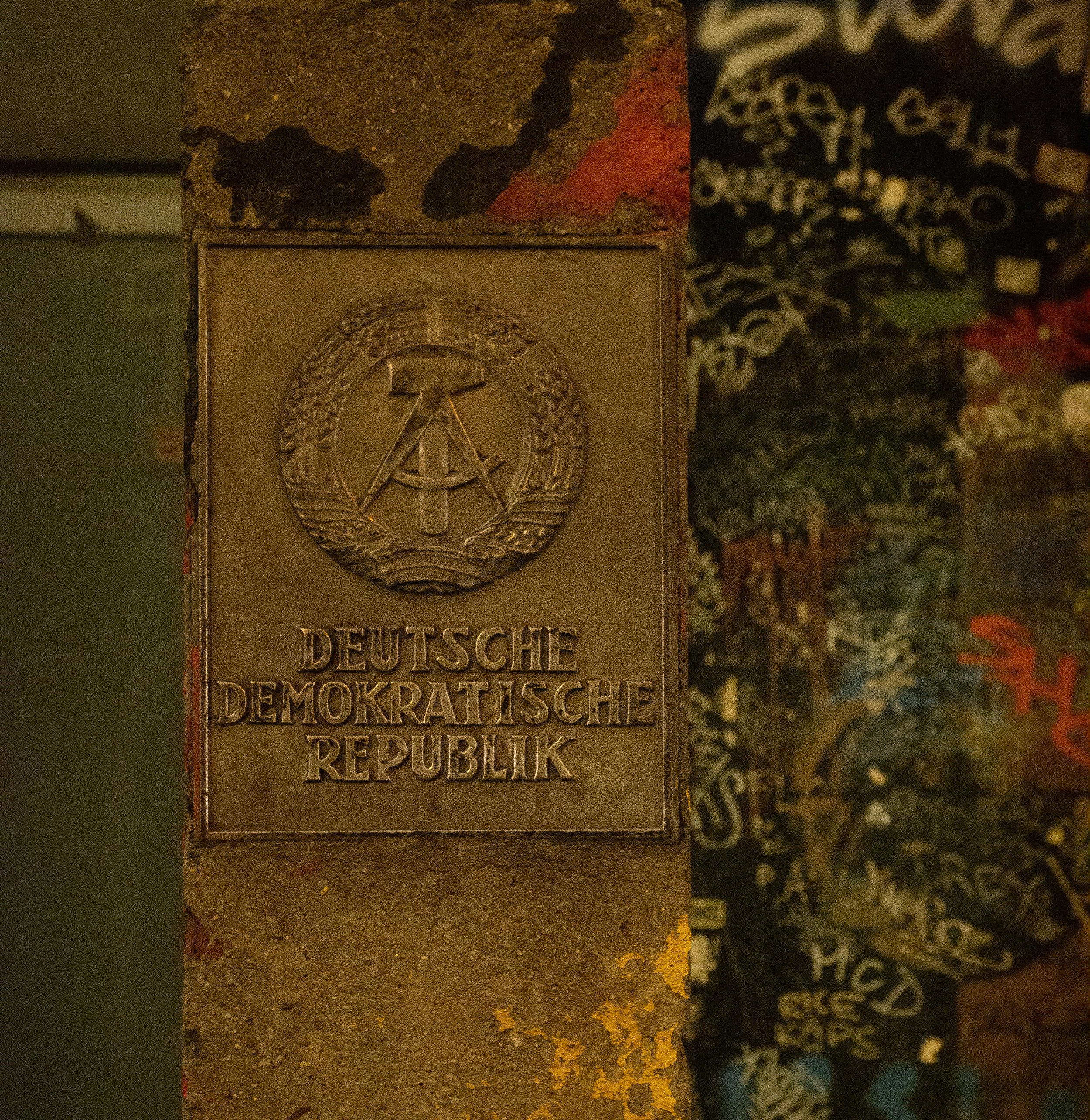Berlin Lessons.
Rain falls silently on the sleeping city. Cobbles, coated in a slippery patina of water, shine under the glow of the streetlights. A car putters along the deserted street, its engine coughing in the silent night. Nothing but an anonymous rust bucket made in Togliatti, its driver returning home to some ghastly Plattenbau in Marzahn.
Still, it was enough of an apparition to startle the figure that was scurrying along the least illuminated of the two sidewalks. The man stopped mid-stride and swivelled around in evident alarm. His face remained unseen, hidden under the wide brim of a rain-soaked hat, as he scanned the street. Nothing but buildings blackened by soot, a few parked cars and wet grime. The only sound was the rain’s, falling over East Berlin.
Satisfied, the man sunk his head in the collar of his coat and continued moving towards Friedrichstrasse, that secret passageway that led to Platform B, West Berlin and freedom.
He was so elated that he didn’t notice the figure re-emerging from a dark hallway just a few steps behind him.
Stories of this kind were my introduction to Berlin. Years of Cold War novels, Robert Ludlum and John Le Carré, cemented an equivalence between this city and intrigue, spycraft, mystery. Berlin, in my mind, ceased to be a physical place and morphed into a landscape of the mind: nocturnal, hidden, unknown.
My Berlin visit coincided with a busy work period and with days of ever-decreasing length. It was with no little amount of glee that I realised how my free moments would coincide with the hours of darkness, either before dawn or after sunset. I could chase my Cold War delusions in the setting that felt the most congenial: night.
And so it was that, every morning and every night, I set out towards topical places from those days when two world orders collided in this city. But, rather than indulging my nostalgia for a time I had the good fortune of not having experienced, Berlin taught me a wholly different lesson about the past. Something a lot more relevant.
The Bundestag at 5 AM under a persistent drizzle makes for an intimidating sight. The epicentre of Germany’s democracy is a behemoth of stone, with a bulk that commands respect. It’s not a surprise, I think as I circle it at a respectful distance, that the Soviets felt it necessary to build such a behemoth of an embassy a few steps away on Unter den Linden, replete with hammer, sickle and stained-glass Kremlin. Just to balance things out.
But the longer I stayed around the Bundestag, the more I started noticing other aspects about the building. Wide openings in the severe stone walls revealed glass portals and large windows giving way to immaculate foyers. Warm light oozed out of the building, almost drawing the visitor in. I was way too early to seize the chance but, had I been able to, I could’ve walked up to a glass dome overlooking the Spree; right beneath my feet would be the plenary hall of the German parliament. Europe’s most powerful politicians would’ve had to look up to see me, Mr Nobody.
And, had I come later, I would’ve also been able to gaze at phrases, names and dates scribbled in Cyrillic by Soviet conscripts that had fought in the erstwhile Reichstag to finish off the regime that killed 20 millions of their compatriots. Their memory, their messages, still follow Germany policymakers as they go about their business.
Another lesson awaited a short distance away. Indiana Jones had it happening in a much more “totalitarian” setting; yet it’s here, in Bebelplatz, that it all took place. It’s here, in this postcard of Mitteleuropa, that the Nazis staged the ritual burning of all books deemed unworthy to be read by the German public. Up in flames went anything, from Jack London to Remarque in bonfires not seen since the days of Dido.
“That was only a prelude, there where they burn books, they burn in the end people” are the prescient words from a Heinrich Heine play from 1821 inscribed on a brass plaque.
A light marks the spot. A perfect square throws a stream of white light in the air above the piazza. Moth-like, I walk towards the glass pane, sensing something underneath it, below street level. There is a chamber beneath, a room dug in the soil of Bebelplatz. It’s a perfect square, painted brilliant white as the light that emanates out of it.
Shelves line all four walls, but they’re all empty. No books line the bookshelves, ready to transmit knowledge and wisdom to aspiring readers; they’ve all gone, sacrificed to the altar of “purity”.
Berlin reserved its last lesson for my last morning in town. I am walking back from Checkpoint Charlie, where a KFC sign accompanies the “You’re leaving the American Sector” notice as if to remark that no fried chicken is to be found beyond that point. A photograph of a clean-shaven Russian soldier hangs from a pole, the young man seeming surprised as he looks West.
I walk along a nondescript road towards my hotel. Wall-to-wall commercial buildings on one side, tram tracks and then the wall of a railway viaduct on the other. The Stadbahn, a sandstone rampart ridden by silent trains even at this early hour of the morning. It’s such an ordinary setting that it takes me a while that the viaduct is littered with bullet holes.
In a city where the remnants of WWII have been carefully expunged, Georgenstrasse’s viaduct is an oddity and a testimony to the battle that was fought in the spring of 1945. A colossal gunfight went down here: thousands of bullet holes constellate the viaduct, barely filled with dark cement. Today the Stadbahn elevated tracks host shops and bars; seventy-five years ago, a whole other kind of traffic went by here.
Later that day I was to learn that Georgenstrasse’s viaduct had been left relatively untouched, its scars visible, as a warning for generations to come. But that was the future; right there and then I stood still for a while, thinking at all those bullets and shells and bombs that didn’t end their journey slamming against a slab of sandstone.
I’d come to Berlin to chase memories of a time where the world was bipolar and perhaps easier to understand. There were two sides: the one opposite was wrong and therefore you were right. That past was not in Berlin anymore, and perhaps it never existed in the first place. But in its stead I found a much more valuable teaching.
No one wants to admit to failures. We all wish we were something better than we actually are; we all wish we could forget those instances when we were in the wrong, skip past all those experiences we’re ashamed of. Before coming here, I only thought it natural for Berlin to be rhyming along the same lines, exalting the beauty of its buildings while skirting around the swastikas worn by the men who built them.
But that wouldn’t be the Berlin way. As my experiences showed, this city went down the harder, and more courageous, path of recognising its past and using it not as a tool for collective flagellation but as a spur to be better. The graffiti on the walls and the bullet holes brought back the pain of war, Bebelplatz the shame; the glass dome overseeing the plenary room of the Bundestag was the answer, the promise to improve.
This was the lesson I brought home from Berlin: own up, learn and improve. It’s only when we accept and recognise the least edifying pages of our past that we – as individuals, cultures, nations – can move on, grow up and, like today’s Berlin, evolve into something brilliant.






